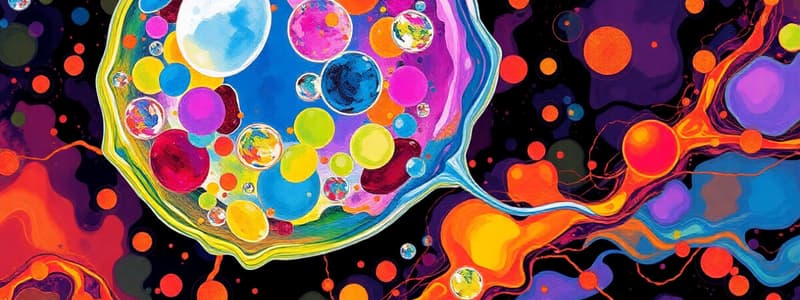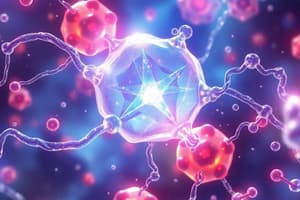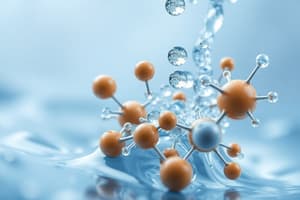Podcast
Questions and Answers
Why does water have unique properties of attraction?
Why does water have unique properties of attraction?
- Because water molecules repel each other.
- Due to the lack of electronegativity difference between hydrogen and oxygen.
- Due to equal sharing of electrons between hydrogen and oxygen atoms.
- Because the slightly positive hydrogen and slightly negative oxygen charges allows water molecules to participate in hydrogen bonds, which causes attraction. (correct)
Hydrophobic substances readily dissolve in water due to their attraction to water molecules.
Hydrophobic substances readily dissolve in water due to their attraction to water molecules.
False (B)
In a solution of sodium chloride (NaCl) in water, the negative portion of water molecules (oxygen-) attracts the _______ sodium ions (Na+).
In a solution of sodium chloride (NaCl) in water, the negative portion of water molecules (oxygen-) attracts the _______ sodium ions (Na+).
positive
Explain how a change in chloride ion concentration in a cell's cytosol can affect the cell's electronegativity, and why this is important.
Explain how a change in chloride ion concentration in a cell's cytosol can affect the cell's electronegativity, and why this is important.
Match the following terms with their correct descriptions:
Match the following terms with their correct descriptions:
Cytosol, the gel-like substance within cells, is primarily composed of what?
Cytosol, the gel-like substance within cells, is primarily composed of what?
Blood is classified as connective tissue because it consists of cellular and non-cellular components.
Blood is classified as connective tissue because it consists of cellular and non-cellular components.
What percentage of blood plasma is water?
What percentage of blood plasma is water?
Life is believed to have originally evolved in a __________ environment.
Life is believed to have originally evolved in a __________ environment.
What is the chemical formula for water?
What is the chemical formula for water?
What type of bond holds hydrogen and oxygen atoms together in a water molecule?
What type of bond holds hydrogen and oxygen atoms together in a water molecule?
Which property best describes a water molecule, considering the unequal sharing of electrons between oxygen and hydrogen?
Which property best describes a water molecule, considering the unequal sharing of electrons between oxygen and hydrogen?
Match the component within living things with its approximate water content.
Match the component within living things with its approximate water content.
Which property of water is primarily responsible for ice floating on liquid water?
Which property of water is primarily responsible for ice floating on liquid water?
Increasing the temperature of water causes hydrogen bonds to form more readily.
Increasing the temperature of water causes hydrogen bonds to form more readily.
Adding a solution like __________ can prevent ice crystals from forming by binding with water's hydrogen bonds.
Adding a solution like __________ can prevent ice crystals from forming by binding with water's hydrogen bonds.
Why does water have a high heat capacity?
Why does water have a high heat capacity?
Explain what happens to the hydrogen bonds in water when it transitions from a liquid to a gas (steam).
Explain what happens to the hydrogen bonds in water when it transitions from a liquid to a gas (steam).
Match each water state with the description of its molecular behavior:
Match each water state with the description of its molecular behavior:
What damaging effect can ice crystal formation have on living cells?
What damaging effect can ice crystal formation have on living cells?
Water has the lowest specific heat capacity of any liquid.
Water has the lowest specific heat capacity of any liquid.
Why is water (specifically blood plasma) effective at dispersing heat in the body?
Why is water (specifically blood plasma) effective at dispersing heat in the body?
Water's cohesive properties cause it to be repelled from charged surfaces such as capillary tubes.
Water's cohesive properties cause it to be repelled from charged surfaces such as capillary tubes.
Explain how water's polarity contributes to its effectiveness as a solvent.
Explain how water's polarity contributes to its effectiveness as a solvent.
The phenomenon where water molecules are attracted to each other, leading to surface tension, is known as ______.
The phenomenon where water molecules are attracted to each other, leading to surface tension, is known as ______.
Match the following properties of water with their descriptions:
Match the following properties of water with their descriptions:
What is the significance of water's adhesive properties in plants?
What is the significance of water's adhesive properties in plants?
Surface tension allows objects denser than water, like rocks, to float.
Surface tension allows objects denser than water, like rocks, to float.
Describe how the dissolving of table salt (NaCl) in water demonstrates water's solvent properties. Include how water interacts with the salt ions.
Describe how the dissolving of table salt (NaCl) in water demonstrates water's solvent properties. Include how water interacts with the salt ions.
Flashcards
Cytosol
Cytosol
The gel-like substance inside cells, mainly water (70-80%), where cellular metabolism occurs.
Tissue
Tissue
A group of cells with a similar function, e.g., connective tissue.
Blood
Blood
A connective tissue with cells (red/white blood cells) and plasma.
Blood Plasma
Blood Plasma
Signup and view all the flashcards
Water Percentage in Life
Water Percentage in Life
Signup and view all the flashcards
Water Chemical Formula
Water Chemical Formula
Signup and view all the flashcards
Covalent Bonds
Covalent Bonds
Signup and view all the flashcards
Polar Molecule
Polar Molecule
Signup and view all the flashcards
Polarity
Polarity
Signup and view all the flashcards
Hydrogen Bond
Hydrogen Bond
Signup and view all the flashcards
Hydrophilic
Hydrophilic
Signup and view all the flashcards
Water's Attraction to Ions
Water's Attraction to Ions
Signup and view all the flashcards
Electronegativity Change in Cytosol
Electronegativity Change in Cytosol
Signup and view all the flashcards
Water's States
Water's States
Signup and view all the flashcards
Liquid Water
Liquid Water
Signup and view all the flashcards
Gaseous Water
Gaseous Water
Signup and view all the flashcards
Solid Water
Solid Water
Signup and view all the flashcards
Freezing cell damage
Freezing cell damage
Signup and view all the flashcards
Preventing Ice Formation
Preventing Ice Formation
Signup and view all the flashcards
Water's High Heat Capacity
Water's High Heat Capacity
Signup and view all the flashcards
Specific Heat Capacity of Water
Specific Heat Capacity of Water
Signup and view all the flashcards
High Heat Capacity
High Heat Capacity
Signup and view all the flashcards
Water as a Solvent
Water as a Solvent
Signup and view all the flashcards
Sphere of Hydration
Sphere of Hydration
Signup and view all the flashcards
Cohesion
Cohesion
Signup and view all the flashcards
Surface Tension
Surface Tension
Signup and view all the flashcards
Adhesion
Adhesion
Signup and view all the flashcards
Water Transport in Plants
Water Transport in Plants
Signup and view all the flashcards
Study Notes
Water in the Cells
- All living things consist of one or more cells with their own cytoplasm.
- Cytoplasm is the main component, containing cytosol (a gel-like substance), organelles like mitochondria, macromolecules, and ions.
- Cytosol is the liquid component of the cytoplasm surrounding intracellular organelles.
- Cytoplasm is the contents of a cell except for the nucleus, including all organelles and the cytosol.
- Cytosol is the medium for cellular metabolism, consisting of 70% to 80% water and is usually colorless.
- Cellular metabolism occurs inside the watery cell contents.
- Water is required for cellular processes like photosynthesis, where carbon dioxide and water produce glucose and oxygen.
Water Around the Cells
- A tissue is a group of cells with a similar function.
- Connective tissue contains a cellular and a non-cellular component.
- Blood is a connective tissue comprised of 45% red/white blood cells and 55% blood plasma.
- Blood plasma is approximately 92% water.
Water in Living Beings
- Water composes about 60-70% of the human body and up to 60-95% of other living things.
- Water is critical for life.
- Brain: 75% water
- Blood: 83% water
- Heart: 79% water
- Bones: 22% water
- Muscles: 75% water
- Liver: 86% water
- Kidneys: 83% water
Origin of Life in Water
- Life likely evolved in a marine (aquatic) environment.
- First came macromolecules, then organelles, and finally cells.
- Hydrothermal vents in the deep ocean provide an environment for life despite lacking light.
Water's Polarity
- Hydrogen and oxygen form covalent bonds in water molecule
- Hydrogen has a slightly positive charge (H+), and oxygen has a slightly negative charge (O-).
- Water's polarity results in water molecules attracting other water molecules and other polar molecules and ions.
- Substances that dissolve in water are hydrophilic.
- Salt consists of sodium chloride (NaCl), where the chemical formula is NaCl.
- The positive portion of water molecules (hydrogen+) attracts negative chloride ions (Cl-).
- The negative portion of water molecules (oxygen-) attracts positive sodium ions (Na+).
- Sodium chloride (NaCl) reacts with the cytosol of a cell and becomes negative chloride ions and positive.
- Ions are important in the context of cellular processes.
- A decrease of chloride ions (Cl-) in an egg's cytosol changes the electronegativity of the cytosol from negative to positive.
Properties of Water
- Three states: gas, liquid, and solid.
- High heat capacity.
- Heat of vaporization.
- Solvent properties.
- Cohesive and adhesive properties.
Water States
- In liquid water, hydrogen bonds constantly form and break as water molecules slide past each other.
- In gas water: as heat rises (as the water boils), water molecules' higher energy causes hydrogen bonds to break completely, allowing water molecules to scape to the air as gas/steam
- In solid water, when the water temperature reduces and the water freezes, the water molecules form a crystalline structure that is maintained by hydrogen bonding.
- Water's lower density in its solid form is due to the way hydrogen bonds orient as they freeze: meaning the water molecules push farther apart compared to liquid water
- Ice floats at the surface of liquid water due to lower water density in its solid form.
- Ice crystals that form upon freezing rupture the delicate cell membrane and proteins required for living cells to function.
- Adding the solution glycerol makes it difficult for ice to form because this solution binds with the hydrogen bonds of water
Water's High Heat Capacity
- Water's high heat capacity happens because of hydrogen bonding among its molecules.
- A small amount of water can hold a lot of heat without its temperature rising.
- It takes a long time to heat water and a long time to cool it.
- Blood plasma is mostly water, which is a great way to disperse and save heat in the body.
- Induction of fever requires ATP.
- A 1°C rise in body temperature requires a 10-12.5% increase in metabolic rate.
Water's Solvent Properties
- Water is a polar molecule with slightly positive and negative charges.
- Ions and polar molecules can dissolve in it easily, making water a great solvent.
- Ions and polar molecules form hydrogen bonds with water.
Cohesive and Adhesive Properties
- Cohesion means water molecules are attracted to each other because of hydrogen bonding.
- Cohesion allows for surface tension.
- Surface tension is the capacity of a substance to withstand rupturing when placed under tension or stress.
- Water appears higher on capillary tube sides because water molecules are attracted to a capillary's charged glass walls more than to each other.
- Adhesive forces create a "pull" on the water column.
- Pull results from the tendency of water molecules evaporating on the plant's surface to stay connected with the water in the plant.
Studying That Suits You
Use AI to generate personalized quizzes and flashcards to suit your learning preferences.
Related Documents
Description
Explore water's unique properties like attraction and its role in dissolving substances. Understand how water interacts with ions in solutions, such as sodium chloride. Investigate the impact of water in biological contexts, from blood plasma composition to early life evolution.




